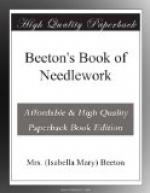ILLUSTRATIONS 95 to 97 (Leaf in Raised Embroidery).—This kind of embroidery is particularly beautiful, as it is worked separately and sewn on the material with an outline in very fine cotton, this produces the shade seen in 95 (see also illustrations 98 to 113). For such leaves work first one half in overcast and satin stitch (illustration 96); the other half is worked on a separate piece of material (see illustration 97); cut away the material along the overcast outline, and fasten it on the foundation material along the outline which forms the veining on illustration 96.
[Illustration: 98.—Raised Embroidered Leaf.]
[Illustration: 99.—Half of Leaf (98).]
[Illustration: 100.—Centre of Leaf (98).]
ILLUSTRATIONS 98 TO 100 show a similar leaf; both halves are worked separately (see 99); the centre is worked in open lace stitch. The latter (see No. 100) is traced, then make ladder stitches across, work the outlines in overcast stitch, and cut away the material underneath the ladder stitch. The cross stitches are then worked in darning stitch with very fine cotton wherever two threads meet.
[Illustration: 101.—Blossom in Satin Stitch.]
ILLUSTRATION 101 (Blossom in Satin Stitch).—The eyelet is worked in overcast stitch, then work the upper part of the blossom all in one piece as far as the beginning of the veining, thence the blossom is worked in two halves.
[Illustration: 102.—Blossom in Satin Stitch.]
[Illustration: 103.—Bead partly covered.]
ILLUSTRATIONS 102 & 103 (Blossom in Satin Stitch).—The raised centre of this flower is formed by a bead, over which the embroidery is worked. When the leaves have been worked one after the other, place a bead in the centre, left free in such a manner that one hole lies on the material, and work over the bead by inserting the needle into its upper hole, then underneath the material, drawing it out above the material close to the bead, and so on (see 103).
[Illustration: 104.—Star in Satin Stitch.]
ILLUSTRATION 104 (Star Pattern in Satin Stitch).—The centre, which forms a wheel, is worked first. Draw the threads across the circle marked by an outline; in the centre they are wound round, always taking one thread on the needle and leaving the next thread under the needle, as can be seen in 122 on the half-finished pattern. The material underneath the wheel is only cut away when the rest of the pattern has been embroidered.
[Illustration: 105.—Star in Point de Reprise.]
ILLUSTRATIONS 105 & 106 (Patterns in Back, Satin, and Ladder Stitches).—The small star in the centre of No. 105 is worked in point de reprise.
[Illustration: 106.—Star.]
[Illustration: 107.—Flower in Satin Stitch.]
ILLUSTRATION 107 (Flower in Satin Stitch).—The fine veinings are worked with fine black silk in point russe, which renders the effect of the flower very beautiful.




